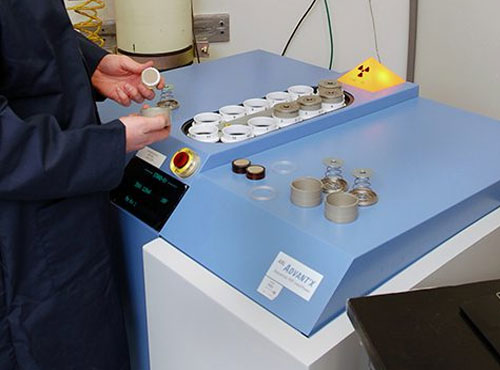
XRF Chemical Analysis
XRF analysis is a non-destructive technique capable of semi-quantitative analysis, alloy ID and RoHS screening.
How XRF Testing is Performed
X-rays are emitted from the miniature X-ray tube in the analyzer and strike the sample, knocking electrons out of the innermost orbitals. Electrons from outer orbitals move into the vacated spots to stabilize the newly created ion, and in the process emit energy (a secondary X-ray photon) that is characteristic to each specific element. This phenomenon is called fluorescence.
XRF Testing - Quantitative Analysis of Materials
Wavelength-Dispersive X-Ray Fluorescence Spectroscopy (WD-XRF) offers the compositional analysis of various metals. The method requires a solid sample able to cover a 29mm diameter opening; however, smaller samples can be accommodated. Note that some light elements (such as boron, beryllium, etc.) cannot be detected via this method.
METALS
- Iron
- Aluminum
- Magnesium
- Titanium
- C0?
- Copper
- Nickle
- Chromium
- Bromium
- Lead
- Cadmium
- Mercury
NON-METALS
- Polymers
- Liquids
- Soils
XRF Testing- Featured Benefits
Timeliness
XRF Testing can be performed quickly, delivering an accurate quantitative analysis on a wide variety of materials
Non-Destructive
XRF Testing is performed with no adverse effects to the material sample
Portable
The analyzer can be used in the hand-held mode or in the integrated test stand. The unit is portable which allows for on-site testing.
Economical
XRF Analysis is less expensive than ICP Testing.
CHEMICAL ANALYSIS SERVICES
- Alloy Chemistry
- Antimony Analysis (ICP)
- Cadmium Analysis (ICP)
- Carbon, Sulfur, Hydrogen, Oxygen & Nitrogen
- Contamination ID
- Contaminant/ Corrodent Analysis
- Filler/Additive Analysis
- FTIR
- Halogen Analysis (IC)
- Heavy Metals Analysis
- Hex Chrome (UV-VIS)
- ICP-AES Analysis
- ICP-MS Analysis
- Impurities Analysis
- Ion Chromatography
- Material Certification
- Metal Purity
- OES Analysis
- On-site PMI
- PMI Testing (Positive Material ID)
- Particle Size Analysis
- Percent Crystallinity
- pH
- Polymer Testing
- Powder Diffraction
- Powdered Metal Analysis
- Precious Metal Assay
- Quantitative Analysis
- Resistivity (ASTM D1125)
- SEM-EDS
- Semi-Quantitative Analysis
- Trace Element Analysis
- Unknown Alloy Identification
- Unknown Material Identification
- XRD Analysis
- XRF Analysis
XRF SAMPLE REQUIREMENTS
The instrument aperture (or window) is about 5 mm in diameter (about the size of a pencil eraser). Samples as small as half this size can be individually analyzed easily, and even smaller samples can be analyzed as long as enough multiple parts are provided. Powder samples can be analyzed by placing enough powder to thoroughly cover the aperture in a clear plastic bag. Samples should be at least 5 mm thick for polymers and 1 mm thick for metal alloys to prevent the X-rays from completely penetrating through the sample.
